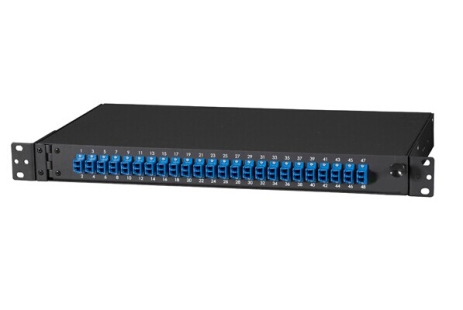Fiber optic patch panel, also known as fiber distribution panel, is used to terminate the fiber optic cable or provide access to the cable’s individual fibers for cross connection.
A fiber patch panel is usually composed of two parts, the compartment that contains fiber adapters (bulkhead receptacles), and the compartment that contains fiber optic splice trays and excess fiber cables.
In most fiber optic patch panels, all of the adapters are of the same type. As we all know, there are various types of cables or connectors used in the network, so it is necessary to equip the fiber optic patch panel with hybrid adapters. These types of adapters can be used to connect different types of connectors on fiber optic cables. In addition, a conversion cable can also solve this problem. The conversion cable is simply a cable with two different types of adapters on either end.
Fiber optic patch panel is commonly used as a fiber optic cable management unit. The network technicians can use fiber optic patch cable to cross-connect, connect to fiber optic communication equipment or test the individual fibers in the fiber optic cable.
Fiber optic patch panel provides a convenient way to operate fiber optic cable connections by plugging in or pulling out the fiber optic patch cable. And selecting signals, arranging or rearranging the circuits can be easily realized without the use of expensive dedicated switching equipment.
Fiber optic patch panel can be an opened box which can create a safe environment for the exposed fibers and fiber optic cables. In the meantime, it can leave a space for fusion splicing and connections of fiber optic adapter components.
Fiber optic patch panel can help with the installation of fiber optic cables as well as increase the density of installation. Also, it can provide more convenience for organization and management.
Wall-mounted fiber optic patch panel can keep 12 different fibers separated from each other. If the fiber optic cable contains more than 12 fibers, the extra fibers can be moved to a second fiber optic patch panel, or the engineer can use a fiber optic patch panel, designed to individually install more fibers, to hold the fibers. Wall-mounted fiber optic patch panel is structured to hold up 144 fibers every time.
Wall-mounted fiber optic patch panels make the inside fiber optic adapter panels, patch cables and pigtails realize the function of optical fiber distribution. And they are used for protecting fiber optic cables and connections of pigtails in fiber optic cabling and user terminal applications. The patch panels are installed on the indoor wall with a terrace which can provide a flexible fiber management system for transiting external device cables to indoor cables and for connector assemblies.

Rack-mounted fiber optic patch panel can hold the fibers horizontally and it is usually designed to open like a drawer. The sliding-opened structure make engineers access to the inside of optical fibers easily. The rack-mounted patch panel is optional with all kinds of fiber optic adapter ports, pre-installed inner trays and accessories. And fiber optic pigtails of different types are optional, such as SC, FC, ST, LC, E2000, etc. Also, rack-mounted patch panels can be customized by the fiber counts.
Rack-mounted fiber patch panel is used for fiber optic cable termination and distribution. And this make it convenient to organize and connect the fiber optic links. Rack-mounted fiber patch panel is suitable for many fiber optical products, such as DWDM MUX DEMUX, Rack Chassis Splitter, Optical Distribution Frame (ODF), etc. They are fully stable with no risk of movement and create a secure environment for fiber optic adapters, patch cables and pigtails.

In recording studios, television and radio broadcast studios, and concert sound reinforcement systems, fiber optic patch panels are widely used to facilitate the connection of different devices, such as microphones, electric or electronic instruments or broadcasting equipment. fiber optic patch panels make it easier to connect different devices in different orders for different projects, because all of the changes can be made at the fiber optic patch panel and it groups all of the input jacks into one location. Fiber optic patch panels are being used more commonly in domestic installations.
When you install and manage the fiber optic links, you may encounter hundreds or even thousands of fiber optic cables and cable connections. At this time, a fiber optic patch panel is a good option because it can help you organize and connect the fiber optic links, and it can protect the cables from damage.